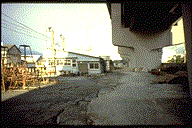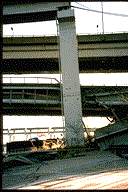3.4 Bridges
Although many elevated highway and railway bridge structures collapsed or were severely damaged during the earthquake, nearly all of this destruction was due to structural rather than foundation failure. Members of the investigation team inspected bases of bridge piers in most areas where the most severe bridge damage occurred; little evidence was observed of penetration or tilting of foundation elements, except for several tilted piers in areas of lateral spreading.
On the Kobe mainland, most of the piers supporting damaged highway and railway bridges were examined. Most of the foundation elements were hidden from direct view by overlying soils and pavements, but the bases of piers extending upward out of the soil were nearly all plumb and undamaged. Above these lower segments, however, structural damage was pervasive and commonly severe. For example, Figure 3.55 shows a spalled bridge pier supporting an elevated highway section. The fissures in the foreground are evidence of ground deformation caused by liquefaction and ground oscillation. In spite of the evident occurrence of liquefaction around the pier, no penetration or tilting of the pier was detected.
 Figure 3.55: Major elevated highway structure in Kobe that suffered considerable spalling of concrete and distress of reinforcing steel in single column support. No evidence of foundation penetration or tilting was detected, even though fissures in foreground and nearby sand boils indicate liquefaction and ground oscillation were pervasive beneath bridge.
Figure 3.55: Major elevated highway structure in Kobe that suffered considerable spalling of concrete and distress of reinforcing steel in single column support. No evidence of foundation penetration or tilting was detected, even though fissures in foreground and nearby sand boils indicate liquefaction and ground oscillation were pervasive beneath bridge.
For some new bridges, especially those with tall piers, ground conditions were an important factor leading to bridge damage. Liquefaction apparently reduced resistance to lateral forces on foundation piles, while lateral spreading imposed increased lateral loads on these same elements. As a consequence, several bridge foundations shifted laterally which caused lateral displacement or tilting of the supported bridge piers. In a few instances, pier displacements were large enough to dislodge bridge girders, causing the girders and deck to fall to the ground. A example of this type of failure is shown in Figure 3.56, where a bridge pier tilted and shifted sufficiently to allow one end of the bridge deck to slip off its bridge seat and fall to the ground. That bridge formed part of a causeway from the mainland to Rokko Island.
 Figure 3.56: Tilting of support on Rokko Island causeway (~40 cm at top) led to drop of girder.
Figure 3.56: Tilting of support on Rokko Island causeway (~40 cm at top) led to drop of girder.
Liquefaction and lateral spreading may have also played a part in the collapse of a section of the Nishinomiya Bridge (Figure 3.57). The entire fill beneath the approach to the failed bridge was disturbed by liquefaction and lateral spreading (Figure 3.58). The lateral ground displacements may have displaced the bridge pier leading to the collapse.
 Figure 3.57: Collapse of a span of the Nishihomiya bridge on the new Harbor Expressway.
Figure 3.57: Collapse of a span of the Nishihomiya bridge on the new Harbor Expressway.
 Figure 3.58: Note liquefaction induced lateral spread fissures and sporadic sand boils near pier of Nishihomiya bridge which previously supported collapsed expressway section.
Figure 3.58: Note liquefaction induced lateral spread fissures and sporadic sand boils near pier of Nishihomiya bridge which previously supported collapsed expressway section.
The damage to bridges with tall columns in areas of liquefaction and lateral ground displacement suggest that more attention should be devoted to making reliable estimates of displacements of bridge columns during earthquakes. Such an analysis should realistically model the response of column and the pile foundation.